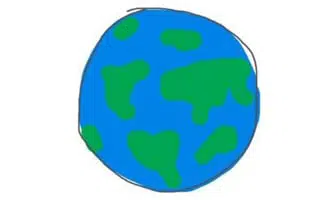When you purchase through links on our site, we may earn a commission. Here’s how it works.

Earth Day is a day to share our practices, values and to find new ways to work together to change the path we are currently on. We look to make more sustainable choices as individuals, as corporations, and as global citizens. Let this be a reminder every year that you make a difference.
The History Of Earth Day
Earth Day was founded decades ago in the heat of Vietnam protest rage and the hippie flower power days of 1970. While the Vietnam war was being fought with honor, the people back home in the US were extremely vocal with protests and some of the most radical uprisings against the government we have ever seen. These actions were led by student groups on college campuses across the country and created a stir that was felt worldwide. These times demonstrated to the U.S. people that they COULD, in fact, make an impact and have their voices heard. The first amendment that promised free speech was alive and well and with this came a sense of power.
With power came a drive to change frustrations beyond the war, including the growing concerns over our natural resources and how they were being wasted. Sure gas guzzling cars were everywhere but there was a growing understanding of the sensitivity of the earth to our actions and habits and with this came the first meaningful environmental movement in the United States which was organized into a day of global awareness-building that was called Earth Day.
Silent Spring Ignites Global Environmental Awareness
Setting the stage for this great day in 1970 was a book called Silent Spring written in 1962 by Rachel Carson. It became a New York Times bestseller and shone a bright light on the growing conflict of the environment, living beings and public health vs. the mechanical age of capitalism. More than 500,000 copies of the book were sold in 24 countries around the world. This was the first global-scale eye-opening moment of the environmental movement to come.
U.S. Government Created Earth Day
Earth Day was founded by a U.S. Senator from Wisconsin named Gaylord Nelson. The tipping point for his vision was the crippling 1969 Santa Barbara, California oil spill and the student protests that resulted. Water and air pollution were thrust into the awareness of the public who were already in rally mode, leading to new agendas for these anti-government public debates and demonstrations. This also forced these pollution issues into the conversations being held in the government arena. Senator Nelson created an idea for a “national teach-in on the environment” which was well received by a few others (Pete McCloskey, a Republican Congressman, served as co-chair and Denis Hayes served as the national coordinator) to gain national press and became the first Earth Day in 1970.
The First Earth Day In 1970
People took the streets in droves to support the first Earth Day in 1970. In fact, 20 million Americans across the country participated in this first Earth Day! So many people had been focusing on issues they had deemed separate (land conservation, wildlife preservation, pollution, landfills, toxic waste, etc.) but now found a common umbrella under which they could combine their efforts for a louder voice of shared concerns and efforts. This was the start of the environmental movement.
Join Your Local Earth Day Movement Every Day
Earth Day, April 22, is a great day to learn what is going on around the globe and in your city as well but remember it is the actions you take every day that will make a true impact. We must think about how we can do more to live sustainable lives every day – not just one day a year. So, celebrate the earth today and take your kids too. They will have fun but will also gain education on what they can do too to make an impact on the future of our planet. Happy Earth Day (and Happy Earth Lifetime)!
About The Earth Day Network
Earth Day Network grew out of the very first Earth Day and has since grown to unimaginable proportions working with more than 22,000 partners and working in 192 different countries. One of the purposes of the Earth Day Network is to broaden, diversify and mobilize the environmental movement. With the help of the Earth Day Network campaigns for awareness, Earth Day has become the largest civic observance in the world!
The Earth Day Network does not only promote green living awareness on one day of the year. They also support events and educational opportunities around the world every day of the year! But for which issues do these activities promote awareness? In addition to the overall importance of taking care of our planet, the Earth Day Network promotes the creation of green jobs, investing in green projects, promoting activism to prevent water and air pollution and turning dilapidated buildings into green buildings.
Focuses Of the Earth Day Network
The Earth Day Network tackles many issues relating to green living, but currently, a handful of projects are at the top of the list.
- Greening Schools and the Promotion of Environmental Education – The Earth Day Network has partnered with the US Green Building Council and the Clinton Foundation to make their Green Schools Campaign come to life. The project intends to turn all of America’s kindergarten through 12th grade schools into green schools within one generation. The reason why this project is being undertaken is multi-pronged, primarily, green schools are much better for the planet, but they also save money while conserving water and energy and result in happier, healthier and higher performing students. The faces behind this program are hopeful that their efforts will foster the next generation to be more environmentally aware and to engage with their local community. By grouping with other organizations, the Earth Day Network also aims to reform not just school facilities but also school food, civic engagement and environmental education.
- Accelerating the Global Green Economy – Promoting the use of renewable energy, energy efficiency and sustainable development is another major project being undertaken by the Earth Day Network (EDN). The EDN promotes this type of sustainable living by creating dialog and holding conferences designed to engage government leaders, corporate leaders and civil society. During these discussions and conferences, the EDN focuses on creating viable ways to transition from the use of a fossil fuel based economy to one that is focused on utilizing renewable resources. A subsection of the global green economy effort being put forth by the Earth Day Network is the WAGE or Women and the Green Economy effort. WAGE is designed to promote the unique leadership role that women can bring as advocates for green efforts in economic and investment policies.
How Are Earth Day Networks Concepts Made Possible?
The policy department of the Earth Day Network is responsible for identifying legislative opportunities on various levels that can advance the mission of the Earth Day Network’s movement. By creating awareness of the global impact possible with local action, the Earth Day Network hopes to diversify, broaden and mobilize the greed effort worldwide.
On a more basic level, the global awareness that the Earth Day Network works to promote is made possible by individuals across the world. Through volunteering, organizing community events, changing lifestyles and making concerted efforts to be energy aware people all around the globe are making a difference every day.
Earth Day Is A Global Campaign For Awareness
Although every year on April 22 the world celebrates Earth Day, the Earth Day Network encourages proponents of Earth-friendly living to take part in the effort every day. There are currently a number of programs being run by the Earth Day Network in addition to domestic efforts and educational efforts. In 1990 Earth Day went “global” and brought together more than two hundred million people from one hundred and forty one different countries to raise awareness. This incredible boost for the Earth Day Network not only laid the foundation for the United Nations Earth Summit in Rio de Janeiro in 1992 but it also led to the recognition of Senator Gaylord Nelson. In 1995 President Bill Clinton awarded the Senator with the highest honor afforded to United States civilians – the Presidential Medal of Freedom.
In 2000 the global efforts were rallied again to promote clean living, and more than five thousand environmental groups from over one hundred and eighty four countries joined in the movement for Earth Day 2000. The global effort that was made in 2000 to raise awareness of Earth day was key in its utilization of digital resources in addition to more traditional means of raising awareness. By 2010 the first state-sponsored Earth Day celebration was held on the African continent in Morocco. The center of this celebration focused attention on to India and encouraged involvement through many means including celebrity music festivals. The incredible success of the 2010 Earth Day celebration resulted in the Earth Day Network creating a permanent program in India with staff based out of Kolkata.
Earth Day Networks Continued Growth
With established programs to raise clean living awareness in the United States as well as in India, Earth Day Networks stay busy year round. The organization does not let these already established programs impede their global reach, however, and each year they continue to reach out to other nations. Today, Earth Day Network carries out yearlong global programs all over the world to increase clean living awareness. One such program that has already had a significant impact on many nations including Haiti, Australia, Brazil, France, Japan and Uganda is the Canopy Project. The Canopy Project is part of the network’s mission to not only preserve the environment but also to protect national lands. As part of this program, Earth Day Network plants trees to assist the economies and sustainability of small communities worldwide. A beneficial side effect of this program is also the increased filtration of the atmosphere that these trees provide.
With increased support and fund raising, the Earth Day Network hopes to be able to increase the number of their programs like the Canopy Project and fun further green living conversion programs globally.
Earth Day Truths Revealed
Smithsonian.com released ten truths that were revealed, and they said a lot about how we treat our environment. Some of the things we have done have had some unexpected positive results, while others are obviously causing more damage to our Earth directly or through global warming. To use this information to increase the positive results and lessen our negative impact on the planet, let us take a look at a few of the facts and discuss how we might build upon them.
Species And Ecosystems
More species are being discovered. Though we as humankind like to think we have learned about all the living things on the planet, this simply is not true. For one thing, it is impossible for us to cover every area of the planet. Even if we did discover every species that lies on the surface of the land on the planet, there is so much water to cover and areas below the surface that it is virtually impossible to know about every species.
We must remember that every single thing we do has an impact on the environment around us. Even small adjustments to any given area can cause vast consequences to the ecosystem. For instance, if you remove one species of plant from your forest, you have just made an impact on the natural gasses in the area as well as life forms that may have relied on that plant for food, camouflage, and even its poisonous properties if it has them. Treat the planet as you would treat a friend’s house. Leave it just as you found it.
Energy Sources
Natural gasses are causing more problems than solutions these days. Some of the emissions from the use of natural gas are creating more global warming than we realized, but that isn’t even the tip of the iceberg when it comes to how our use of natural gasses has impacted the planet. We are not only using a resource that is not renewable and may actually serve the planet in some way that we are unaware of, but our methods of transporting natural gas, the way we modify it, and finally our actual use of the end product are all areas that have an impact on the planet.
When we think of using natural gas, we generally only consider the fact that we are consuming a resource that we cannot replace. But what happens to the ecosystem where the natural gas was originally found? We don’t even know what exactly it might do for other life forms in its natural state. Just by removing it from where it originated, we have an impact on an ecosystem. Keep in mind that each small impact on any given ecosystem reverberates through every ecosystem around it and continues until the reverberation is complete.
When we transport it, we use valuable resources for the actual transportation, but what happens when there is a problem during transportation? We pollute the land, the water, and any living thing in the area. Again, an ecosystem suffers. It doesn’t just stop there either. At some point, we actually use the natural gas and pollute the air with the emissions from it. In short, there is no positive impact on the planet at all from the use of natural gas.
Wind Farms
Wind farms give us some hope in several ways. The most obvious way is that these wind farms replace other methods of creating energy for us to consume. This replacement can lower our negative impact on the environment, which is good for us and the environment, though it is not likely to reverse any damage that we have already done. It is a step in the right direction.
Offshore wind farms might actually benefit the environment as they offer new options for birds and possibly other living things found in the ocean that may do well to have a solid structure in their vicinity. In the middle of a vast ocean, those that live in the air may find the offshore wind farms a welcome place of rest. If this continues, the wind farms might even become part of a regular flight pattern.
Organic Food Sources
One of the areas in which we have the largest impact, but place some of the least focus on is our consumption of food. Did you know that you can contribute to global warming just by eating meat? While you don’t have to cut out meat completely, you might want to start looking at what happens to the meat before it gets to you. All of the chemicals that go into the production of the meat are a contributing factor when it comes to global warming, as is almost every other step in the way of meat production. The pesticides used to produce the food that we feed to our potential steak dinner are enough to have an enormous impact on the environment.
Speaking of pesticides, it might be a good idea to avoid killing living things that are beneficial to us when it comes to growing plants and flowers. Let’s stop killing the bees, shall we? Pesticides are starting to intrude on their world, and that is bad news for us. Unless you look forward to doing some form of hand-pollination on every crop you plan to raise, why not avoid pesticides and instead give our bees a chance to rebuild their population.
Organic farming includes the use of all natural fertilizers and what you may refer to as “pesticides” in a limited way. There is no poison being put into the air, and human-made chemicals are not being introduced into the ecosystem. Instead, organic farmers rely on nature’s own methods to keep the land healthy and prevent insects from consuming crops. You don’t have to commit genocide on a species to get them to leave your crop alone. Just dissuade them from being there, while still recognizing their benefits to the ecosystem in general.
How Will You Participate In Earth Day?
Share stories from past years that might inspire new participants to join in the celebration of our Mother Earth!
How will you spend Earth Day this year?
Tagged With:

